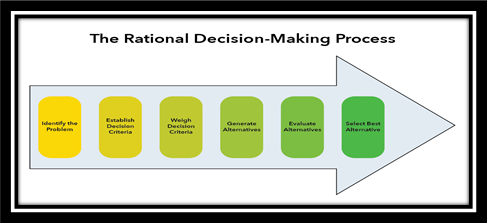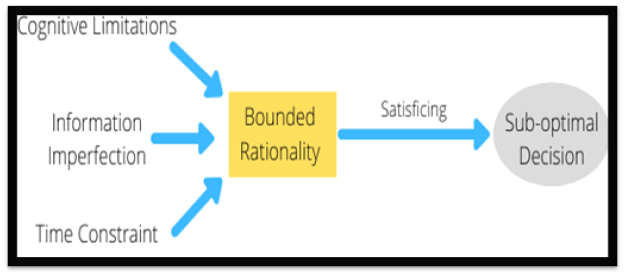Decision Making Assignment: Decision Style Analysis Reflective Report
Question
Task:
Fast changing workplaces call for greater flexibility in the ways individuals and work teams make and implement decisions. Alongside the increasing rate of change are the demands for better decision making through understanding and mitigating personal preferences and biases.
Decision Making Assignment Writing Guidelines:
This decision making assignment draws on learning activities and resources. It is designed for you to engage in the decision-making process and then reflectively analyse your decision-making process using only theories and concepts from the Business Decision Analytics course (MGT602). You should include in your reflective report:
- The decision-making problem detailed by your learning facilitator
- Analysis of your decision-making preferences
- Analysis and influence of your personality traits and the impact on your decision-making
- Details of the sources of data collected during the decision-making process and how this data was evaluated/analysed
- Analysis of the decision-making process using any of the models
- Visual interpretation of data / trends/ patterns
- As a reflective analysis you will present your analysis in the first person.
Answer
Introduction
Following decision making assignment establishes in-depth understanding of learning that is being acquired from Module 1 and 2. Objective of carrying out this study is to develop and involve in decision-making process with the help of some theories and models. Theories included in this study like “Intuitive decision-making model”, “rational decision-making model” and many more mostly taken from the two modules that are offered in blackboard of this study. Through analysis of this theories and models, I can develop and portray my decision-making process and at the same time pinpoint limitations in my decision-making process and ways to improve them for a better professional career.
Analysis and Evaluation
Decision-making is something that businesses and hominids have to do on a regular basis. Decisions are the most important part for the formulation of a plan that would in the success of a business (Koechlin, 2020). Thereby, decision-making is a process that makes the human element alive and keeps them functional. The fundamental thing in decision-making is the involvement of choices. The various decision-making theories that help in the determination of optimal decisions, as has been mentioned in the modules are many. Of them, the “Intuitive decision-making model” and “rational decision-making model” stands as the most potent. This is majorly because these two decision-making models are opposite to each other.
Rational decision-making model explains the fact that individuals are to utilize the facts and the information (Module 2 of the Course). There is a clear analysis in the rational decision-making model and a procedure that is carried on systematically. This model is crucial and of utmost significance because it is a more advanced type of decision-making model (Module 2 of the Course). Rational decision-making process is carried out in particular steps. There are certain core steps that are imperative for this model.
The first step is the identification of the problem. The second step entails the establishment of particular decision criteria. Weighing that decision criteria is the third step. The fourth significant step is the generation of alternatives. The fifth step involves the evaluation of those alternatives. The last step includes the selection of the best alternative (Power et al, 2019). In my opinion, this model is an effective solution to figure out complex situation. For instance, I generally look out for solution from roots cause of problem, it is important to establish strong foundation. Use of this model in my daily life has helped me to overcome critical challenges, from applying to particular jobs to completion of certain projects. I certainly believe that in my professional career also this model will have major play, as in critical situation I have to figure out problems, establish effective decision-making process, and select best alternatives to solve the situation.

Figure 1: Rational Decision-Making Model
(Source: Power et al, 2019)
Multiple other decision-making models used for business analytics. Apart from the rational and intuitive decision-making models, the “bounded rationality” in decision making stands as a potential decision-making theory, as has been mentioned in Module 2 of the Course. This is one of the most efficient human decision-making models. It aims at providing satisfaction rather than optimization. This decision-making model is appropriate for business due to the fact that it enables the humans to make important decisions that usually departs from the perfect overview of economic rationality. This is majorly due to the fact that rationality of human beings is vastly limited by the thinking capacities of humans, the information that is available to them and by time (Cohen et al, 2019).
Hence, instead of making the best choice for a business, sometimes organizations are prone to making choices, which are satisfactory. This yields good results for the business. Bounded rationality decision model helps in making suboptimal decisions. This is mainly due to three underlying factors. They are cognitive limitations, imperfect information and time constraints (Hong, 2019). In contrary to my personal experience, there has been situation for which I have to take decision that are of best of choices at that moment, however, making certain suboptimal decision becomes crucial at that point.
On the other hand, rational decision-making model also deserves special mention (Module 2 of the Course). This model enables me to assume that human beings would make choices that would aid in the maximization of their benefits and minimization of any cost. This is particularly crucial for every business, since the major agenda of every business is the maximization of benefits and minimization of costs. I believe that rational decision-making process provides a solution to take better decision with proper utilization of data and information (Cao et al, 2019).

Figure 2: Bounded rationality Decision Making Model
(Source: Boyce, 2021)
There are certain processes of business that almost every organization is performing on a daily basis. This is what keeps the organization structured and results in the generation of fruitful outcomes from their businesses. It is important for the businesses to remain effective and efficient. Thereby decision-making is something that is fundamental to every business. As it has been discussed in Module 1 that, the decision-making tools acts as very useful and beneficial for impact analysis. It is essential for businesses to take real-time decision-making abilities. There prevail many points of views in a decision-making. I usually fail to deliver that in many occasions, as there has been situation where I failed to make effective decision due to complexity of the situation. If in that case I used certain business model like “Dual processing model”, this model provides two different thinking systems, one that occur automatic and other that happens after better consideration of various concepts a taking effective decision. This increases the productivity level of the businesses (Watts & Buckley, 2017).
Another decision-making model that is the naturalistic decision-making, which is different from above mentioned models, is less complex and can provide flexibility in modern day business. Policy framework of this model refers to making decision-making much easier and standardised. It is necessary for modern day’s business models. With complex real-world settings including dynamic, lot of uncertainty and continuously changing business conditions (Cao et al. 2019). It is essential for businesses to take real-time decision-making abilities. Gaining significant knowledge in this model can help me to develop my decision-making abilities to take crucial decision in stress and uncertainty (Falzer, 2018).
Earlier, I was not able to utilize fullest of information and resources to take effective decision, it is natural for human beings to take wrong decision in stress situation. However, gaining experiences from particular situation has helped me to take decision that is much more measured. Gaining experiences in any field can have major role in taking of effective decision; organization usually opts for experienced candidates having relevant knowledge and skills. As this provides modern day businesses to take crucial decision in fast pace business environment and implement them to provide business to be in better position.
However, even though the decision-making theories have their own benefits, yet there are major limitations that should always be taken into consideration. One of the major limitations lies in the fact that business analytics might require a second diagram style when they are modelling their business processes and operations, which includes the decisions (Hong, 2019). This makes the process much more complicated. Apart from that, only those rules required by known decisions are shown and this may eventually give rise to major misconceptions regarding the number of business rules and regulations that are actually required. Certain decision-making theories and tools can often cause the stakeholders to believe that their decision models have been standardized. This provides a fake hope, which might cause havoc for the organization.
Poor data quality and difficulty in analysing of various data sources can lead to current business leaders not make effective use of above discussed models. As in current business environment, use of various sources is essential in order to get better analytics. However, systems may have problems in accessing various data collection platforms, thus, incorporation of advanced software systems are essential for taking systematic decision. Along with that, organization may have large amount of data at their disposal, but at times it can prove to be problematic. Large data means large analytics, which can be time consuming; this can slow decision-making process as this data can include useless and irrelevant information. Therefore, “data quality management” initiative can provide today’s business leaders to set off best practices for data management (Kunc & O’brien, 2019).
Conclusion
From this study, it can be determined that decision-making process is a crucial part in ones professional as well personal life. With changing business environment, organizations are demanding for individuals those are confident enough to take crucial decision after proper utilization of resources available. Efficient adherence to proper decision-making aids in the breaking down of complex decision into much more simple decision. Along with that, proper implementation of various decision-making model helps in various situations. In my opinion, various models have their own importance, however, taking account of fast changing business environment naturalistic business decision-making process provides better platforms for organization.
Bibliography
Boyce, P. (2021). Bounded Rationality (Definition and 3 Examples) - BoyceWire. Retrieved 1 October 2021, from https://boycewire.com/bounded-rationality-definition/
Cao, G., Duan, Y., & Cadden, T. (2019). The link between information processing capability and competitive advantage mediated through decision-making effectiveness. International Journal of Information Management, 44, 121-131. Retrieved 1 October 2021, from https://www.sciencedirect.com/science/article/pii/S0268401218306893 .
Cohen, S. L., Bingham, C. B., & Hallen, B. L. (2019). The role of accelerator designs in mitigating bounded rationality in new ventures. Decision making assignment Administrative Science Quarterly, 64(4), 810-854. Retrieved 1 October 2021, from https://journals.sagepub.com/doi/abs/10.1177/0001839218782131
.Falzer, P. R. (2018). Naturalistic decision making and the practice of health care. Journal of Cognitive Engineering and Decision Making, 12(3), 178-193. Retrieved 1 October 2021, from https://journals.sagepub.com/doi/abs/10.1177/1555343418773915 .
Hong, S. (2019). A behavioral model of public organizations: Bounded rationality, performance feedback, and negativity bias. Journal of Public Administration Research and Theory, 29(1), 1-17. Retrieved 1 October 2021, from https://academic.oup.com/jpart/article-abstract/29/1/1/5106458 .
Koechlin, E. (2020). Human Decision-Making beyond the rational decision theory. Trends in cognitive sciences, 24(1), 4-6. https://www.sciencedirect.com/science/article/pii/S1364661319302591 .
Kunc, M., & O’brien, F. A. (2019). The role of business analytics in supporting strategy processes: Opportunities and limitations. Journal of the Operational Research Society, 70(6), 974-985. Retrieved 1 October 2021, from https://www.tandfonline.com/doi/abs/10.1080/01605682.2018.1475104 .
Power, D. J., Cyphert, D., & Roth, R. M. (2019). Analytics, bias, and evidence: the quest for rational decision making. Journal of Decision Systems, 28(2), 120-137. https://www.tandfonline.com/doi/abs/10.1080/12460125.2019.1623534 .
Watts, L. L., & Buckley, M. R. (2017). A dual-processing model of moral whistleblowing in organizations. Journal of Business Ethics, 146(3), 669-683. Retrieved 1 October 2021, from https://link.springer.com/article/10.1007/s10551-015-2913-9 .












